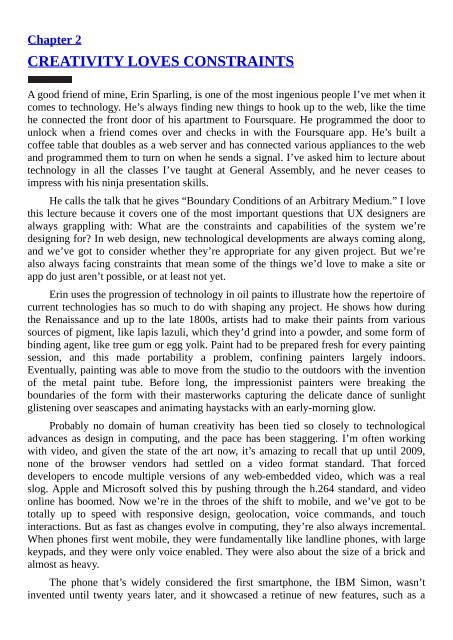You also want an ePaper? Increase the reach of your titles
YUMPU automatically turns print PDFs into web optimized ePapers that Google loves.
Chapter 2<br />
CREATIVITY LOVES CONSTRAINTS<br />
A good friend of mine, Erin Sparling, is one of the most ingenious people I’ve met when it<br />
comes to technology. He’s always finding new things to hook up to the web, like the time<br />
he connected the front door of his apartment to Foursquare. He programmed the door to<br />
unlock when a friend comes over and checks in with the Foursquare app. He’s built a<br />
coffee table that doubles as a web server and has connected various appliances to the web<br />
and programmed them to turn on when he sends a signal. I’ve asked him to lecture about<br />
technology in all the classes I’ve taught at General Assembly, and he never ceases to<br />
impress with his ninja presentation skills.<br />
He calls the talk that he gives “Boundary Conditions of an Arbitrary Medium.” I love<br />
this lecture because it covers one of the most important questions that UX designers are<br />
always grappling with: What are the constraints and capabilities of the system we’re<br />
designing for? In web design, new technological developments are always coming along,<br />
and we’ve got to consider whether they’re appropriate for any given project. But we’re<br />
also always facing constraints that mean some of the things we’d love to make a site or<br />
app do just aren’t possible, or at least not yet.<br />
Erin uses the progression of technology in oil paints to illustrate how the repertoire of<br />
current technologies has so much to do with shaping any project. He shows how during<br />
the Renaissance and up to the late 1800s, artists had to make their paints from various<br />
sources of pigment, like lapis lazuli, which they’d grind into a powder, and some form of<br />
binding agent, like tree gum or egg yolk. Paint had to be prepared fresh for every painting<br />
session, and this made portability a problem, confining painters largely indoors.<br />
Eventually, painting was able to move from the studio to the outdoors with the invention<br />
of the metal paint tube. Before long, the impressionist painters were breaking the<br />
boundaries of the form with their masterworks capturing the delicate dance of sunlight<br />
glistening over seascapes and animating haystacks with an early-morning glow.<br />
Probably no domain of human creativity has been tied so closely to technological<br />
advances as design in computing, and the pace has been staggering. I’m often working<br />
with video, and given the state of the art now, it’s amazing to recall that up until 2009,<br />
none of the browser vendors had settled on a video format standard. That forced<br />
developers to encode multiple versions of any web-embedded video, which was a real<br />
slog. Apple and Microsoft solved this by pushing through the h.264 standard, and video<br />
online has boomed. Now we’re in the throes of the shift to mobile, and we’ve got to be<br />
totally up to speed with responsive design, geolocation, voice commands, and touch<br />
interactions. But as fast as changes evolve in computing, they’re also always incremental.<br />
When phones first went mobile, they were fundamentally like landline phones, with large<br />
keypads, and they were only voice enabled. They were also about the size of a brick and<br />
almost as heavy.<br />
The phone that’s widely considered the first smartphone, the IBM Simon, wasn’t<br />
invented until twenty years later, and it showcased a retinue of new features, such as a


